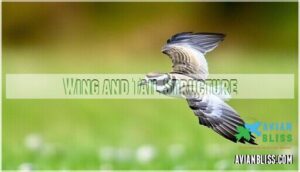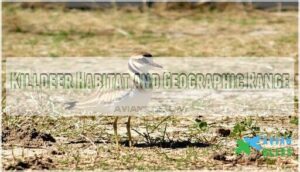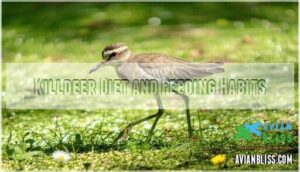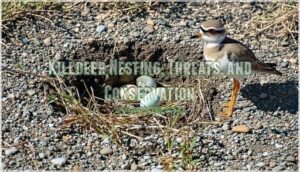This site is supported by our readers. We may earn a commission, at no cost to you, if you purchase through links.

The name might sound fierce, but this plover trades talons for quick wits—master of the broken-wing feint and adept at thriving in fields, playgrounds, and parking lots alike.
Whether it’s weaving through traffic or blending into a patch of stones, the killdeer lives by its instincts, revealing how wild neighbors find safety, food, and family right under your nose.
Table Of Contents
- Key Takeaways
- Killdeer Identification and Key Features
- Killdeer Habitat and Geographic Range
- Killdeer Behavior and Adaptations
- Killdeer Diet and Feeding Habits
- Killdeer Nesting, Threats, and Conservation
- Frequently Asked Questions (FAQs)
- Why do they call them killdeer?
- Do killdeer lay eggs in gravel?
- Do killdeer babies stay in the nest?
- Why do killdeer nest in rocks?
- What adaptations aid Killdeer in predator avoidance?
- How do Killdeer communicate with each other?
- What role do Killdeer play in ecosystems?
- When is the best time to observe Killdeer?
- How have Killdeer populations changed over time?
- How long do killdeer live in the wild?
- Conclusion
Key Takeaways
- Killdeer are easy to spot by their two black chest bands, long legs, and loud, sharp calls, often seen running across open fields or gravel.
- These birds thrive in both natural grasslands and human-made areas like parking lots and playgrounds, showing strong adaptation to changing habitats.
- Killdeer use clever behaviors like the broken-wing display to protect their young and rely on insect-rich diets, foraging quickly across the ground.
- Nesting directly on the ground, killdeer face threats from predators, habitat loss, and human activity, but conservation laws and monitoring help support their populations.
Killdeer Identification and Key Features
If you want to spot a killdeer, it’s helpful to know what makes this bird stand out. There are a few key features that make identification easier.
Let’s look at the main things you’ll notice first.
Size, Shape, and Plumage
If you spot a bird with a round head, long legs, and sleek wings darting across a field, there’s a good chance you’re looking at a killdeer. Its body proportions set it apart from robins. Killdeer show plumage variation through the seasons, thanks to their molting process. Compare their size and shape using these key features:
- Large, round head
- Slender, pointed wings
- Long, thin legs
- Sleek brown-and-white plumage
Distinctive Coloration and Markings
After noticing the killdeer’s bold shape and plumage, you’ll see its striking color pattern—two crisp black bands across a white belly and a warm brown back that make it easy to recognize. Look for sharp facial markings and color camouflage, which help with bird identification. Chick down shows softer plumage variations, while adults display more defined band patterns.
| Feature | Description |
|---|---|
| Band Patterns | Two black bands, belly |
| Facial Markings | White, brown, sharp |
| Plumage Variations | Chick down, adult bands |
| Color Camouflage | Brown back, blends in |
Wing and Tail Structure
Once you’ve picked out the killdeer’s bold stripes and colors, you’ll notice its long, pointed tail and sleek wings set it apart from other birds you might see nearby. These features help with flight adaptations and quick escapes. The killdeer’s wing aerodynamics and tail functionality make it agile. Look for:
- Slender wingspan
- Pointed tail tip
- Distinct feather structure
- Seasonal molting process
- Noticeable size shape measurements
Killdeer Habitat and Geographic Range
Killdeer live almost anywhere you look, from grassy fields to city edges. You’ll spot them in all kinds of places, not just near water.
Let’s look at where these clever birds make themselves at home.
Natural and Open Habitats
Did you know killdeer thrive in places where open fields stretch out like a welcome mat, from grassy lawns to sun-drenched riverbanks? These birds favor Grassland Ecosystems, Wetland Habitats, and even Barren Landscapes.
Thanks to their remarkable adaptability, killdeer can cope with both shrinking habitats and the shifting climate, which in turn shapes where you’ll spot them on today’s bird habitat maps.
Urban and Human-Made Environments
From the edge of busy parking lots to the quiet corners of golf courses, killdeer have learned to make themselves right at home in places shaped by people. You’ll spot them nesting on gravel rooftops, airports, and athletic fields.
Their urban adaptation helps them thrive, but roadside dangers and building collisions remain real risks in these human-made habitats.
Migration Patterns and Seasonal Movements
As winter loosens its grip, you’ll notice killdeer shifting northward across North America, guided by migration triggers like dropping temperatures. Their migratory flexibility means movement depends on climate effects, not a strict schedule.
Stopover habitats—mudflats, fields, sandbars—offer food and rest. Population distribution changes with the seasons, as this shorebird’s breeding range stretches impressively wide.
Keep an eye on eBird sighting information for up-to-date locations.
Killdeer Behavior and Adaptations
When you watch a Killdeer, you’ll notice some clever tricks and habits. These birds have a few standout behaviors that help them survive and protect their young.
Here’s what you can expect to see from Killdeer in the wild.
Broken-Wing Distraction Display
This brokenwing display is a classic example of predator evasion. Killdeer feign injury, luring threats away from their vulnerable chicks.
You’ll notice different display variations, all meant to confuse predators. The evolutionary origins of this distraction display highlight its effectiveness—predator avoidance and chick protection go hand in hand.
It’s a smart predator defense, proven by countless effectiveness analyses.
Territoriality and Vocalizations
When you hear a sharp, ringing call echo across a field, chances are a killdeer is staking its claim and warning others to keep their distance. Killdeer vocalizations and communication rely on a varied vocal repertoire. Their calls serve three main purposes:
- Territory Defense
- Alarm Calls for predators
- Pair Bonding and daily communication signals
Each call is clear and purposeful.
Ground Foraging Habits
If you spot a killdeer darting across a gravel path, it’s likely searching for its next meal with quick steps and sharp eyes. Killdeer feeding habits rely on rapid foraging speed and precise prey detection. Their diet shifts with seasonal variation and habitat influence, helping them improve foraging for invertebrates.
See how foraging techniques differ below:
| Prey Detection | Foraging Speed | Habitat Influence |
|---|---|---|
| Visual search | Rapid steps | Gravel, lawns |
| Ground pecking | Pausing often | Fields, wetlands |
| Quick strikes | Dodging debris | Urban edges |
Killdeer Diet and Feeding Habits
If you’ve ever watched a killdeer search for food, you might wonder what keeps these active birds fueled. Their meals and feeding habits are shaped by where they live and what they find.
Here’s what you should know about how killdeer eat and forage.
Insect-Based Diet and Prey Selection
Did you know insects make up over 80% of the killdeer’s diet? Beetles, grasshoppers, and caterpillars top the list, showing true Insect Prey Dominance. Earthworms and snails—Alternative Invertebrates—come next.
Killdeers nest in open areas with good visibility. Vertebrate Consumption is rare, but killdeer play a key Pest Control role, shifting their Feeding Behavior with the seasons and habitat changes.
Foraging Techniques and Locations
You might spot a killdeer darting across a gravel road or a grassy field, pausing every few steps to snatch up a tasty insect just as easily as it finds its next meal.
Here’s how killdeer foraging works:
- Visual prey detection
- Quick running bursts
- Seasonal variations in technique
- Habitat influence on locations
- Foraging efficiency shapes diet diversity
Water Intake and Supplementary Foods
After all that busy hunting on dry land, killdeer still need water and a few extra snacks to round out their meals. They sip from puddles or shallow ponds for hydration.
You might also spot them picking at seeds, pausing to nibble mineral licks, or gulping down small pebbles—the grit they eat makes digestion a little easier.
These little routines keep the killdeer nourished and well-equipped for foraging all year long.
Killdeer Nesting, Threats, and Conservation
Let’s take a closer look at how killdeer birds nest and care for their young. You’ll also see what challenges these birds face and the ways people work to protect them. Here are the main areas to keep in mind.
Ground Nesting and Parental Care
Nestled right on the ground, killdeer families start their story in open spaces where parents watch over eggs and chicks with vigilant care. Here’s how their nesting habits play out:
- Nest Site Selection: Adults scrape shallow nests in gravel or grass.
- Clutch Size: Usually three to four eggs per brood.
- Incubation Period: Lasts less than a month.
- Chick Development: Young run soon after hatching, guided by parental defense.
Common Threats and Human Impacts
After chicks hatch, dangers quickly stack up. Pesticide poisoning from treated lawns and fields, habitat degradation, and urban collisions with vehicles or buildings all threaten killdeer survival.
Predation threats—like cats, dogs, and wild animals—add to the risk. These pressures, along with ongoing habitat disturbance, have led to a noticeable population decline across many regions.
Conservation Status and Legal Protections
As the killdeer’s conservation status changes across North America, efforts like IUCN reclassification and stronger treaty enforcement are helping to keep them protected.
More focus is now being placed on planning habitats, monitoring populations, and cutting back on pesticide use to support their survival.
The American Bird Conservancy and other partners support these measures, ensuring the American Migratory Bird Treaty Act and similar laws safeguard killdeer conservation and respond to growing population threats.
Frequently Asked Questions (FAQs)
Why do they call them killdeer?
Like a bell ringing through a quiet field, the name “killdeer” comes from its sharp, persistent call.
Vocalization analysis shows the killdeer call sounds like “kill-deer,” making it an onomatopoeic, regionally rooted name.
Do killdeer lay eggs in gravel?
Eggs often end up nestled in gravel, thanks to careful nest site selection. Gravel nest camouflage helps hide them from predators.
The gravel composition impact can influence chick survival rate, compared to alternative nesting sites like lawns or fields.
Do killdeer babies stay in the nest?
Precocial development means killdeer chicks leave the nest soon after hatching. Chick mobility is impressive; guided by parents, they search for food.
Post-hatch care focuses on safety, not nest life. Fledgling independence starts early.
Why do killdeer nest in rocks?
Rock Nest Advantages include excellent Camouflage Benefits, helping eggs blend in and avoid predators. Thermal Regulation and Drainage Factors also play a role, as rocks keep nests dry and warm.
Killdeer nesting behavior favors such Nesting areas.
What adaptations aid Killdeer in predator avoidance?
Imagine a skilled actor on stage—Killdeer use a Distraction Display, Camouflage Plumage, and Vocal Warnings.
Quick Chick Mobility and smart Habitat Selection all play roles in their predator avoidance and famous brokenwing act.
How do Killdeer communicate with each other?
You’ll notice Killdeer bird behavior includes a rich vocal repertoire. Their Vocalization Types range from Alarm Calls to Mating Displays.
Chick Communication uses high-pitched sounds and Visual Signals, all essential to Killdeer behavior and bird behavior.
What role do Killdeer play in ecosystems?
Trophic interactions truly thrive thanks to these insectivores. By controlling invertebrates, supporting seed dispersal, and responding to habitat disturbance, they act as ecosystem engineers—maintaining habitat health while filling an essential ecological niche among predators and prey.
When is the best time to observe Killdeer?
You’ll spot the most Killdeer during Peak Migration in spring or fall. Breeding Season also brings active courtship displays and vocalizations.
Diurnal Activity means daylight is best, though Weather Influence and Regional Variations affect their visibility.
How have Killdeer populations changed over time?
Population fluctuations have occurred due to habitat loss, climate change, and pesticide impact.
Conservation measures and legal protections play an important role. Ongoing efforts like the North American Breeding Bird Survey and the Continental Concern Score help track the Killdeer’s population, habitats, and overall conservation status.
How long do killdeer live in the wild?
Regarding lifespan, the average longevity of a Killdeer bird in the wild is three to five years. Some individuals reach a maximum age of ten.
Lifespan factors include wild threats, migration patterns, and data collection methods.
Conclusion
Picture the killdeer as a living compass, pointing you toward the hidden wonders in ordinary places. Its bold stripes and quick steps remind you that nature thrives even where concrete meets grass.
Each call is a gentle signal, inviting you to notice what’s often overlooked. By understanding the killdeer’s habits and needs, you help protect a species that bridges wild and human worlds.
Let its resilience inspire you to safeguard the quiet life around you.
- https://macaulaylibrary.org/photo/29463571
- https://www.youtube.com/watch?v=qviXH1K5Xpc
- https://www.birdwatchingdaily.com/beginners/birding-faq/the-first-birds-of-spring-which-species-arrive-first-and-why/
- https://www.allaboutbirds.org/guide/Killdeer/maps-range
- https://animaldiversity.org/accounts/Charadrius_vociferus/










